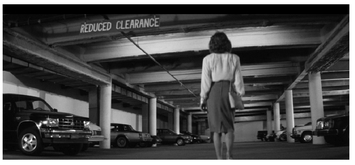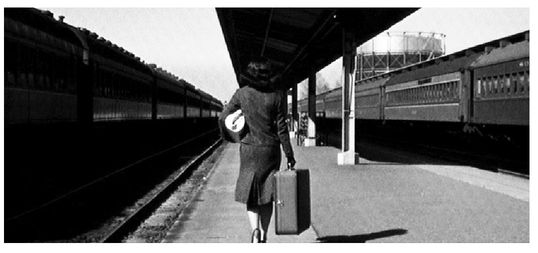Thirty-Nine Steps
(43:11)
Holly, played by Meg Foster, enters story and frame in an explicitly Hitchcockian shot, derived from the opening of Marnie particularly: walking away from a worm’s-eye view, our sense of receding perspective enhanced by her framing in the center of the pillar-and-beam architecture of a parking garage. A neat pale-gray purse and matching heels, plus Foster’s hypnotically smooth stride, complete the reference.
Nada’s lurking in the garage. Improvising a plan to convey himself out of the bank’s vicinity, he’ll carjack Holly, making her the last arriving of the film’s major characters. Here, They Live slows, to give the two a chance to make their pensive, peculiar connection—a truth-sinking-in interlude for both Nada and the viewer—and to tempt us briefly with notions of solace, exchanged confidences, even romance. But it’s to be a wrong number, in the end.
There’s a tenacious movie archetype afoot in this next six minutes of film: the persecuted (usually wrongly accused) man who attaches himself to or absconds with an unwilling female, who then finds herself challenged to evaluate his protestations of innocence, and/or the credibility of the paranoiac plot he claims to be the target of. The point of origin is probably The 39 Steps (1935); if some earlier denominator exists, credit for conveyance of this narrative gesture into the filmgoer’s imaginative stockpile surely goes to Hitchcock anyway, and he reuses it, with variations, in Young and Innocent, Saboteur, and North by Northwest. (Even Rear Window has an element of paranoid-guy-pleads-his-case.)
The gesture often involves some negotiation of class difference, or simply a taming-of-the-shrew toppling of the heroine’s snobbish reserve toward a frantic Everyman. The great example, outside Hitchcock, is the Robert Redford-Faye Dunaway relationship in Sydney Pollack’s Three Days of the Condor (1975); Pollack deftly shifts the film’s subjectivity toward Dunaway’s character, letting us feel the threat of Redford’s invasion of her sanctuary even as we’re rooting for him to persuade her of his story. Nada’s kidnapping of Holly feels like a compressed low-budget retread or even satire of Condor, due partly to the poor man’s Dunaway of Meg Foster’s sultry-bordering-on-somnolent performance: you’re no Redford, Piper, and, no, you’re not getting any! The versatile 39 Steps motif found its nadir in Richard Donner’s punishingly literal Conspiracy Theory (1997), where the distance between Mel Gibson’s justified paranoiac (complete with stalker behavior and black government helicopters) and the harassed patience of Julia Roberts proves to be a bridge not worth crossing. Something like blowing up into the sly next minutes of They Live into a glib and shrill full-length feature.


